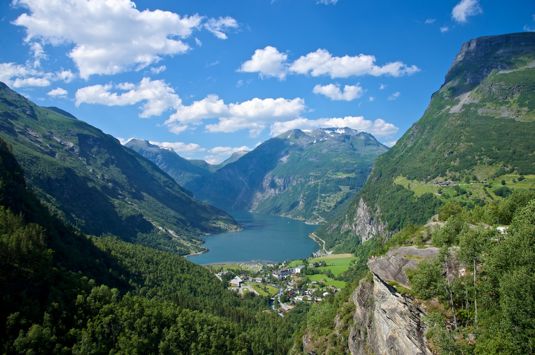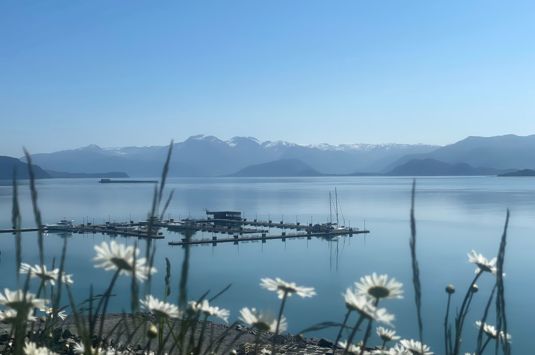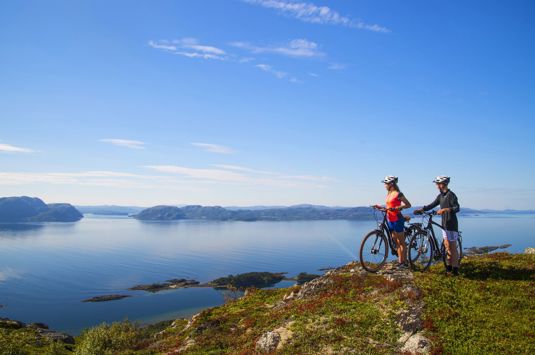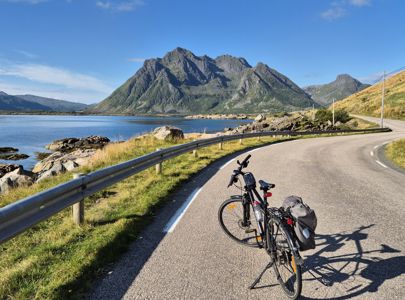
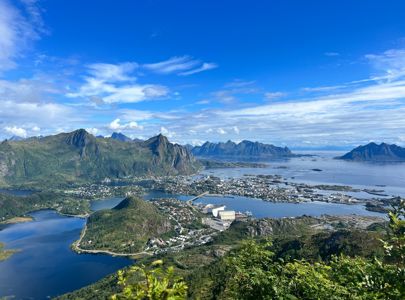
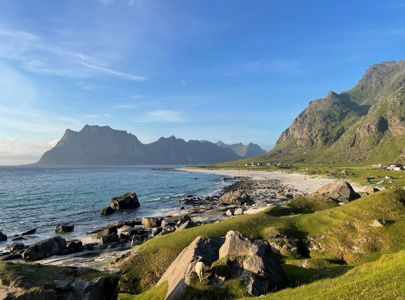
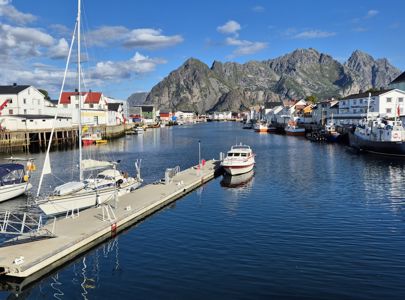
Lofoten Islands Cycling Tour
Luggage transfer
Midnight sun/Northern Lights
Spectacular scenery
Picturesque fishing villages
Optional activities
7 x accommodation | 7 x breakfast | 6 x self-packed lunch | 3 x dinner | Bicycle ferry | Luggage transfer (1 item pre person) | Greenfee discount - Lofoten Links | Tour description | App with access to maps, tracks, vouchers and all necessary travel documents
This tour must be booked no later than 60 days prior to departure.
The Lofoten Islands Cycling Tour is one of the world’s most breathtaking adventures. Towering peaks, turquoise waters, and small fishing villages create a landscape so unique that it feels almost unreal. Many travelers dream of experiencing Lofoten at least once in their lifetime, and what better way to do so than from the seat of a bike?
Every season in Lofoten has its own magic. From June to mid-July, the Midnight Sun paints the sky in glowing colors that never fade, while from late August onwards, the nights return and bring the first dances of the Northern Lights. Whether you visit in summer or autumn, cycling here lets you experience these natural wonders up close.
Your journey begins in Svolvær, where boats rest quietly in the harbor beneath mountain ridges. As you pedal further, the islands reveal one highlight after another: the famous fishing village Henningsvær, spread across tiny islets; the white sandy beaches and wild beauty around Hov; and the historic village of Nusfjord, a UNESCO heritage site that offers a glimpse into Norway’s maritime history.
The road winds through green valleys where sheep graze, past rivers and small family farms. Finally, the journey ends in Reine, a village often described as one of the most beautiful in the world, surrounded by dramatic peaks and crystal-clear fjords. Cycling in Lofoten is about more than scenery. It’s also about discovering local culture in small museums and galleries, and the chance to combine your ride with activities like kayaking, hiking, or fishing.
Since Lofoten is a popular summer destination, with limited hotels and busy roads in the main season, it’s important to plan ahead. To make the most of each stage, accommodation varies from fishermen’s cabins to lodges and hotels. For those seeking a quieter journey, spring and autumn bring fewer visitors and a more peaceful atmosphere.
A bike trip in Lofoten is more than a holiday—it’s a journey through one of the most extraordinary landscapes in the world. From the Midnight Sun to the Northern Lights, from dramatic mountains to white beaches, this Arctic paradise promises moments that will stay with you long after the journey ends.
For an alternative, with less traffic, we recommend Round trip in Vesterålen
Part of the route follows the Norwegian Scenic Route Lofoten and parts follows the signposted National Cycle Route 1 (The coastal route) and EuroVelo 1 (Atlantic Coast Route).
Book your cycling tour through the Lofoten Islands with Discover Norway!
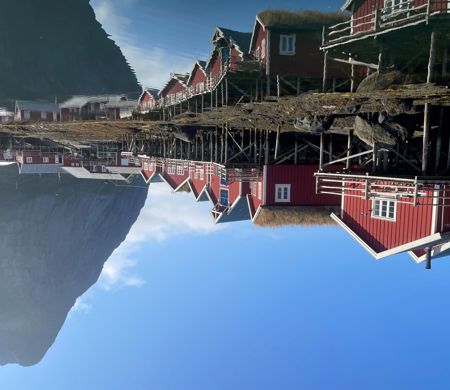
Our bike tour in the Lofoten Islands was a wonderful experience. Pure nature, beautiful dry weather and excellent organization. Everything went perfectly.
Luggage transfer
Midnight sun/Northern Lights
Spectacular scenery
Picturesque fishing villages
Optional activities
7 x accommodation | 7 x breakfast | 6 x self-packed lunch | 3 x dinner | Bicycle ferry | Luggage transfer (1 item pre person) | Greenfee discount - Lofoten Links | Tour description | App with access to maps, tracks, vouchers and all necessary travel documents
This tour must be booked no later than 60 days prior to departure.
-
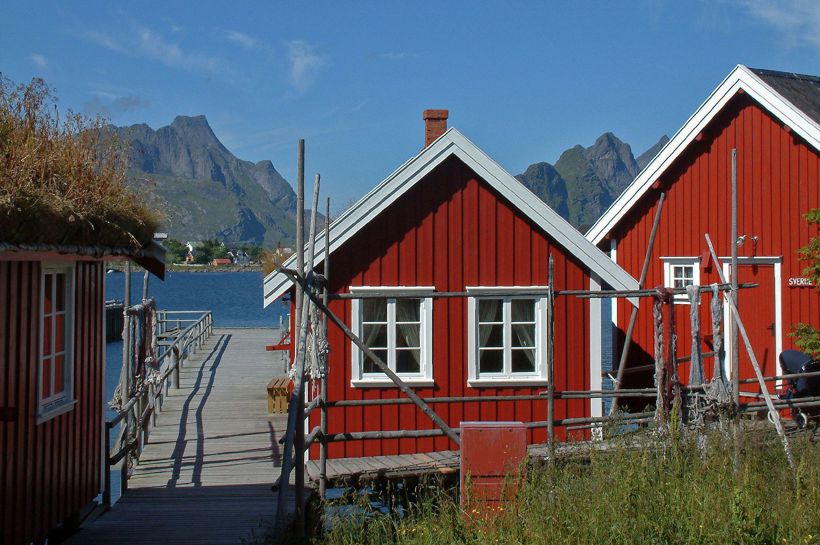 Photo: Classic Hotels Norway
Photo: Classic Hotels Norway
Number of participants:
2 - 16 people on each departure
Price per person 2026:
NOK 25,600.- in a doubleroom
Single room supplement:
NOK 11,800.- (single room on request only)
Extra:
Topographic map: NOK 350.-
2 hr sea kayaking from Svolvær NOK 1,095.- per person
Sea Eagle RIB safari to Trollfjorden (from Svolvær): NOK 1,350 per person
Bike rental 7 days, including return transport from Reine:
Touring/trekking bike incl. double pannier: NOK 3,500.-
E-bike incl. double pannier: NOK 5,500.-
All bikes will come with a bottle holder, front/back lights, pump, spare inner tube, puncture repair kit, High visibility vest and a helmet.
Not included in the price:
Travel- and cancellation insurance
Beverages, snacks
Dinner in Svolvær and Leknes
In Reine, you stay in rorbu cabins. Please be aware that you have to share the cabin (bathroom, living room etc.) with others, who have booked the same trip with Discover Norway. When you stay overnight in Rorbu Cabins you get your own sleeping room in accordance with your booking.
Please note that most 2-bedroom comfort cabins feature one larger double bedroom and a second, smaller bedroom with either a bunk bed or two single beds in the loft, and one bathroom.
Lofoten is a very attractive holiday destination during the summer season, and it is hard to get accommodation. Unfortunately, we are not able to offer one fisherman's cabin for each booking.
History
It all started in the 1100s, as King Øystein Magnusson built so-called rorbu cabins and a church for the fishermen of Vågan. This tells us that even a thousand years ago, the Lofoten Fishery was of considerable importance, and that the Rorbu cabins were a well-established form of accommodation. The cabins were very crowded, and often two or three men would sleep head to feet in the same bed. Up until the mid-1850's, candles were the only lighting in use, as well as the flames from the open fire.
The «finer» cabins had a window in the form of a hole in the wall with a skin made from the stomach of a halibut stretched across it. Stoves and glass window panes did not appear until the late 1800's. In 1896, as many as 2671 Rorbu Cabins were registered in the Lofoten Isles.
Now, most of the fishermen stay on board their boats. What were once lodgings for the fishermen during the seasonal cod-rush have now become accommodation for tourists. In many of the cabins, however, the interior fittings from the turn of the century have still been preserved.
Standard
The Rorbu Cabins are an important part of Lofoten's cultural heritage. It has been important to preserve the environment in their original simple style and to have certain guidelines in terms of refurbishment both indoors and outdoors.
The challenge is to satisfy tourists' increasing demands on standards while maintaining the Rorbu Cabins as they once were.
The cabins are all different. On your trip in Lofoten, you will experience different standards and very different levels of refurbishment. The cabins now have modern facilities, but the old surfaces are well kept, with holes for tools in the walls, and simple worn floorboards. Where there are two floors, you can expect to find something that looks more like a ladder than a staircase to get upstairs.







